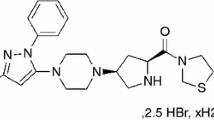Abstract
Differential scanning calorimetry (DSC) is a primary technique for measuring the thermal properties of materials, which reflects the physico-chemical properties of drug substances. In the present study, it is used as a screening technique for assessing the compatibility of sitagliptin with some currently employed pharmaceutical excipients. The influence of processing conditions and their effects (simple blending, co-grinding or kneading) on drug stability was evaluated. Sitagliptin showed a sharp endothermic peak at 212.1 °C with an enthalpy change of 131.5 J g−1 indicating melting of drug. Facile transformation of dehydrated sitagliptin to monohydrate form was observed in some mixtures, disappearance of sharp melting endothermic peak of sitagliptin was observed in some mixtures. On the basis of DSC results, sitagliptin was found to be compatible with micro crystalline cellulose, croscarmellose, and pregelatinized starch. Some excipient interaction was observed with magnesium stearate, ascorbic acid, and citric acid. X-ray diffractometry and FT-IR were used as supportive tools in interpreting the DSC results. Overall, the excipients selected were compatible with the API and the mixtures are stable within the tested conditions. These results would be useful for formulation development of the film coated tablets of sitaglitptin.






Similar content being viewed by others
References
Jackson K, Young D, Pant S. Drug–excipient interactions and their affect on absorption. Pharm Sci Technol Today. 2000;3(10):336–45.
Giron DJ. Applications of thermal analysis in the pharmaceutical industry. J Pharm Biomed Anal. 1986;4(6):755–70.
Chaves LL, Rolim LA, Gonçalves ML, Vieira AC, Alves LD, Soares MF, Rolim-Neto PJ. Study of stability and drug–excipient compatibility of diethylcarbamazine citrate. J Therm Anal Calorim. 2013;111(3):2179–86.
Pani NR, Nath LK, Acharya S, Bhuniya B. Application of DSC, IST, and FTIR study in the compatibility testing of nateglinide with different pharmaceutical excipients. J Therm Anal Calorim. 2012;108(1):219–26.
Kumar N, Goindi S, Saini B, Bansal G. Thermal characterization and compatibility studies of itraconazole and excipients for development of solid lipid nanoparticles. J Therm Anal Calorim. 2013;. doi:10.1007/s10973-013-3237-6.
Ford JL. The use of thermal analysis in pre formulation compatibility testing. Freiburg: Acta Symposium on Pharmacy and Thermal Analysis; 1993. p. 2.
Venkataram S, Khohlokwane M, Wallis SH. Differential scanning calorimetry as a quick scanning technique for solid state stability studies. Drug Dev Ind Pharm. 1995;21:847.
Botha SA, Lotter AP. Compatibility study between naproxen and tablet excipients using differential scanning calorimetry. Drug Dev Ind Pharm. 1990;16:673–83.
Lin SY, Han RY. Differential scanning calorimetry as a screening technique to determine the compatibility of salbutamol sulfate with excipients. Pharmazie. 1992;47:266–8.
Monkhouse DC, Maderich A. Whither compatibility testing? Drug Dev Ind Pharm. 1989;15:2115–30.
Chiu MH, Prenner EJ. Differential scanning calorimetry: an invaluable tool for a detailed thermodynamic characterization of macromolecules and their interactions. J Pharm Biol Sci. 2011;3:39–59.
Verma RK, Garg S. Selection of excipients for extended release formulations of glipizide through drug–excipient compatibility testing. J Pharm Biomed Anal. 2004;38:633–44.
Giron D. Applications of thermal analysis and coupled techniques in pharmaceutical industry. J Therm Anal Calorim. 2002;68:335–57.
Kirtansinh G. Application of analytical techniques in preformulation study: a review. IJPBA. 2011;2(5):1319–26.
Gallwitz B. Sitagliptin: profile of a novel DPP-4 inhibitor for the treatment of type 2 diabetes (update). Drugs Today. 2007;43(11):801–14.
Kumar SS, Krishnaveni Y, Ramesh G. Simultaneous estimation of sitagliptin and pioglitazone by UV-spectroscopic method and study of interference of various excipients on this combination of drugs. Int J Curr Pharm Res. 2012;4(2):113–6.
Wyttenbach N, Birringer C, Alsenz J, Kuentz M. Drug–excipient compatibility testing using a high-throughput approach and statistical design. Pharm Dev Technol. 2005;10(4):499–505.
Te Wierik GH, Eissens AC, Besemer AC, Lerk CF. Preparation, characterization, and pharmaceutical application of linear dextrins. II. Complexation and dispersion of drugs with amylodextrin by freeze-drying and kneading. Pharm Res. 1993;10(9):1280–4.
Novel salts of sitagliptin. European Patent Application. 2010. LEK Pharmaceuticals., https://data.epo.org/publicationserver/rest/v1.0/publicationdates/20100818/patents/EP2218721NWA1/document.pdf. Accessed 23 Apr 2013.
Assessment Report for Januvia. European Medicines Agency. 2009. Doc. Ref: EMEA/363653/2009, http://www.ema.europa.eu/docs/en_GB/document_library/EPAR_-Assessment_Report_-_Variation/human/000722/WC500039129.pdf. Accessed 23 Apr 2013.
Acknowledgements
The authors wish to thank United States Pharmacopeia-India Private Limited for supporting this work. The authors wish to thank Dr. Ahmed Kamal, Project Director, National Institute of Pharmaceutical Education & Research, Hyderabad for his constant encouragement. One of the author Mr. Shanti Kumar Saladi is grateful to the Department of Pharmaceuticals (Ministry of Chemicals and Fertilizers), New Delhi, for Ph.D (Pharm.) fellowship. We would also like to thank Dr. P. Sanath Kumar for their cooperation in carrying out this work.
Author information
Authors and Affiliations
Corresponding author
Rights and permissions
About this article
Cite this article
Shantikumar, S., Sreekanth, G., SurendraNath, K.V. et al. Compatibility study between sitagliptin and pharmaceutical excipients used in solid dosage forms. J Therm Anal Calorim 115, 2423–2428 (2014). https://doi.org/10.1007/s10973-013-3329-3
Received:
Accepted:
Published:
Issue Date:
DOI: https://doi.org/10.1007/s10973-013-3329-3




